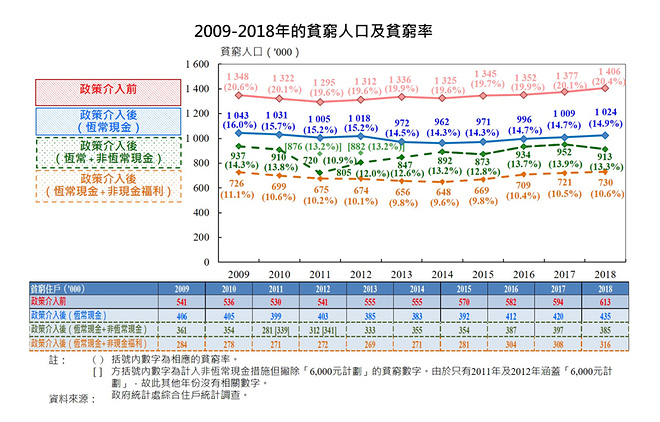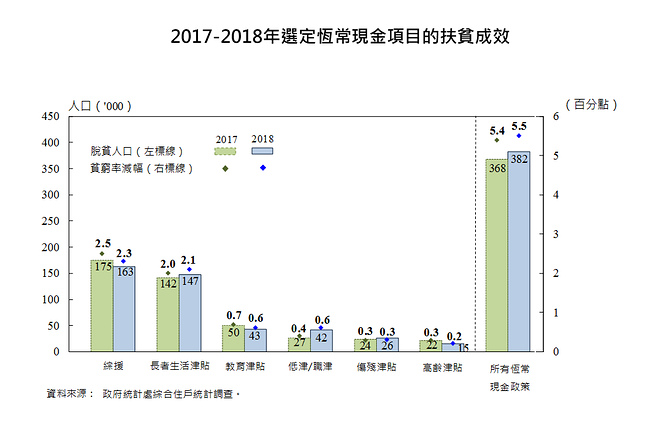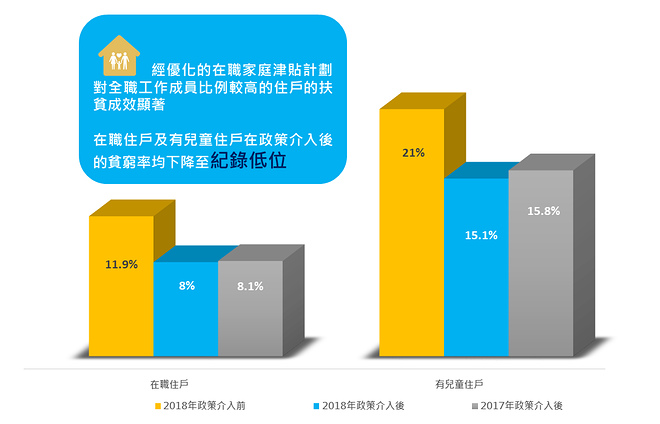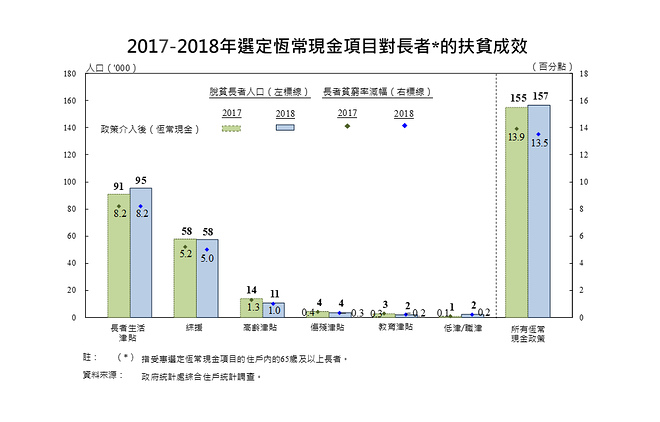Press ahead with poverty alleviation efforts: poverty figures have basic limitations
15 December 2019
The Government released the “Hong Kong Poverty Situation Report 2018” last Friday (13 December). Despite a slight increase in the overall poverty figures, the poor population of 1 024 000 persons (14.9%) after taking into account the Government’s recurrent cash policy intervention indicates that about 380 000 persons have been lifted out of poverty. This represents a decrease of 5.5% in the poverty rate in comparison with the pre-intervention figure of 1 406 000 people (20.4%).
The Government’s strengthened efforts in poverty alleviation through enhanced measures for working families, children and elderly persons were gradually delivering results. The poverty alleviation impact of the Government’s recurrent cash policies in 2018 was the most notable since the commencement of poverty data compilation. Among various recurrent cash benefits, the Comprehensive Social Security Assistance (CSSA) and the Old Age Living Allowance (OALA) had the largest impact on poverty alleviation, reducing the overall poverty rate by 2.3% and 2.1% respectively and lifting a total of about 310 000 people out of poverty.
Upon implementation of the enhanced measures (including increasing all rates of allowance and adding a tier of 3/4 allowance rate), the Working Family Allowance (WFA) Scheme, with a Child Allowance, has significantly alleviated the poverty situation of households with a higher ratio of full-time working members as well as those with children. For example, the poverty rates of working households and with-children households after policy intervention have both dropped to a low level (8% and 15.1% respectively, representing a decrease of 0.1% and 0.7% when compared with 2017).
The enhanced OALA lifted about 95 000 elderly people out of poverty (over 4 000 more than that in 2017) and reduced the elderly poverty rate by 8.2%. As the OALA enhancements came into effect progressively in the recent two years, the elderly coverage ratio of the social security system had increased by nearly 1% compared with 2016 to 73%.
Apart from recurrent cash benefits, the Government also provides the grassroots with various non-recurrent cash benefits (including one-off relief measures) and in-kind benefits (mainly provision of public rental housing (PRH)). In 2018, non-recurrent cash benefits reduced the poor population to 913 000, with the poverty rate dropping to 13.3%. After taking into account in-kind benefits, the poor population further decreased to 730 000 with the poverty rate lowering to 10.6%, reflecting that PRH provision has played a pivotal role in poverty alleviation.
Limitations of poverty figures
The Government has been increasing the recurrent expenditure on social welfare in recent years. The amount has significantly increased by 97% from $42.8 billion in 2012-13 to $84.3 billion (estimated figure) in 2019-20, demonstrating the Government’s steadfast commitment in poverty alleviation. One may ask why poverty figures are still on a rising trend despite the Government’s strengthened poverty alleviation efforts.
In fact, the change in poverty figures is not only affected by policy intervention. It also reflects the outcome of various factors at play, including the economic situation, changes in the overall employment income and demographic changes. I would like to elaborate on the following:
Poverty alleviation effects offset by the ageing of the population
The increase in the elderly population in 2018 (4.3%) was higher than its average growth rate over the past decade (3.8% from 2009 to 2018). The proportion of elderly people in the overall population was as high as 16.9%, much higher than 12.5% in 2009. Such structural changes caused by population ageing have exerted upward pressure on the overall poverty figures.
Meanwhile, the “Poverty Line” takes household income as the sole indicator by measuring income only without considering assets, as a result of which persons “having low income but owning assets of a certain value” (e.g. retired elders) are easily classified as poor. Besides, among the poor elders in non-CSSA households in 2018 (representing 89.2% of the overall poor elderly population), more than 80% had no financial needs. This demonstrates that population ageing is the major cause for the rise in poverty figures in recent years.
Effectiveness of livelihood policies not fully reflected
The main analysis of the “Poverty Line” only takes into account the Government’s recurrent cash intervention and does not reflect the effects of non-means-tested in-kind benefits. Some one-off relief measures, the Elderly Health Care Voucher Scheme, the Public Transport Fare Concession Scheme for the Elderly and Eligible Persons with Disabilities ($2 Scheme) and tuition waiver/assistance policies are also not captured by the analytical framework of the “Poverty Line”. However, such benefits have indeed provided substantial support for grassroots families. It is apparent that the poverty figures do not fully reflect the effectiveness of the Government’s overall efforts in poverty alleviation.
Given the structural limitations of the “Poverty Line”, we should consider those livelihood measures not covered therein as well when interpreting the data in order to obtain a more comprehensive and objective understanding of the poverty situation and the strength of our policies in poverty alleviation.
Poverty alleviation is an enduring task that sees no end. The Government has been making strategic efforts to alleviate poverty with determination and vision. In response to the uncertain economic and employment outlook, four rounds of relief measures were introduced by the Government in the second half of 2019. Besides, the Chief Executive proposed in the 2019 Policy Address a series of measures to improve people’s livelihood, with a view to further catering for the needs of children from different backgrounds, encouraging employment and alleviating inter-generational poverty. Among them, the key recurrent cash measures include improving the CSSA Scheme, raising all payment rates of the WFA substantially (with an increase in the Child Allowance by as much as 40%), regularising the annual provision of the student grant of $2,500, increasing both the monthly subsidy rate and subsidy cap of the Public Transport Fare Subsidy Scheme, etc. The Government will continue to review and examine the progress and effectiveness of various assistance programmes to prevent and alleviate poverty.





